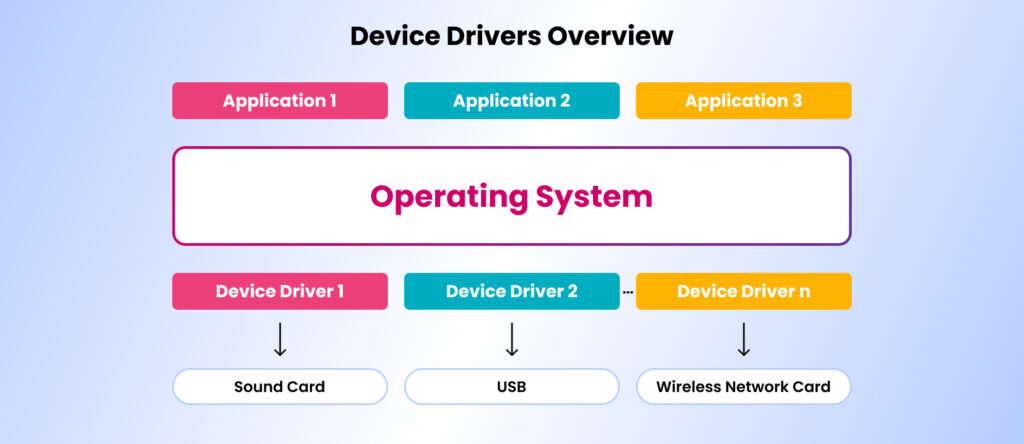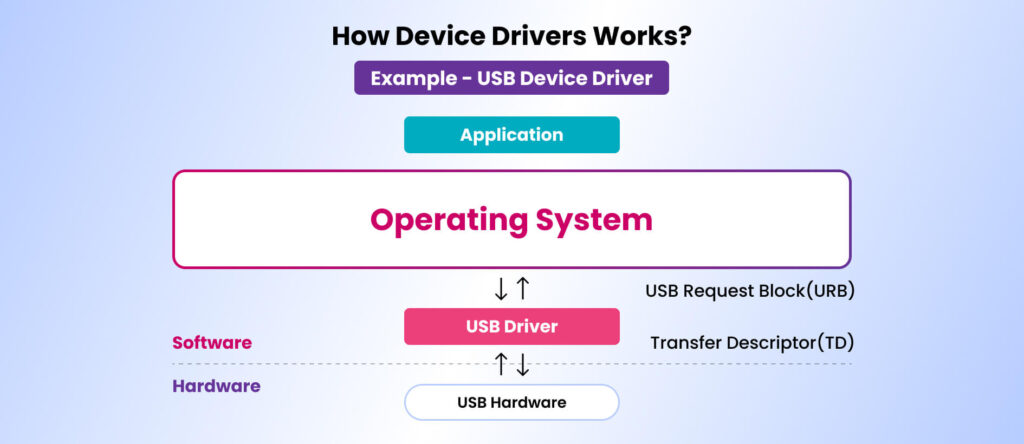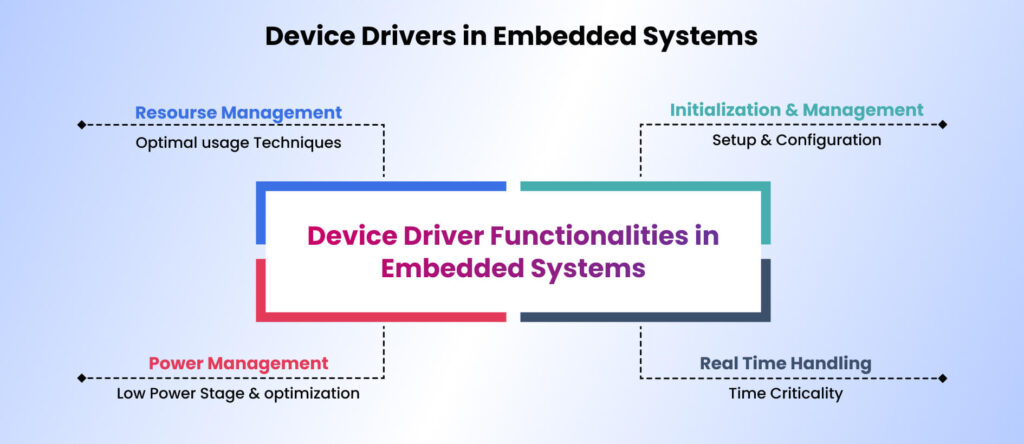Introduction
In the domain of computer systems, the term device driver holds a significant place, acting as a bridge between the hardware and software components. Device drivers are a software that directly interfaces with and controls this hardware. In Embedded Systems, the importance of device driver is all the more important because of the customized and diversified set of hardware is has. To start with, these hardware requires some type of software initialization and management, which is done by the device driver.
Apart from that, device driver in embedded system perform various other functionalities like power management, performance throughout of the system, enabling two way communication and ensuring that overall the system resources are optimized. This blog post is aimed for a beginner who want to get started with device drivers by building initial understanding. We will cover what, why and how aspects of device driver development in embedded systems. Let us dive in!
What are Device Drivers?

Device Drivers are computer programs that act as interpreters between your computer’s operating system and the various hardware devices connected to the computer. They allow the operating system to communicate with the hardware and give instructions on how to function. In simple terms, a Device Driver is essentially an instruction manual for the computer that tells it how to use the device you just plugged in. Without Device Drivers, your computer wouldn’t be able to recognize or use any of the devices attached to it, like a printer, keyboard, or mouse.
Let us understand device driver in embedded system with a help of a simple analogy! Think of a busy city full of machines: printers, monitors, inter networking interfaces like WiFi, hard drives and graphic cards chit-chatting. But these peripherals or hardware speak different language than the conductor, the operating system, that runs the city smoothly. That’s where device drivers come in- they act as interpreters, translating the conductor’s instructions into a language each machine understands. With their help, the printer knows what to print, the hard drive knows where to store data, the graphics card displays visuals on screen. So, the smooth operation of the computer is ensured by device drivers!
As you can see, the main purpose of device driver development in embedded systems is to provide abstraction by acting as a translator between a hardware device and the applications or operating systems that use it. Due to this, Programmers can write higher-level application code independently of whatever specific hardware the end-user is using Application programming languages like Java, Python or JavaScript. On the other hand device drivers, since they are dealing with hardware are typically written in C or C++ or sometimes Assembly level language also. The idea is to create the most optimized source code for device drivers.
How do Device Drivers Work ?

When a command is executed for a specific operation, the operating system sends the instruction to the device driver. The device driver, in turn, communicates with the specific hardware device, relaying the instructions. Once the hardware device completes the operation, it sends the result back to the device driver, which intercepts and delivers it to the operating system. For example, when you plug in a USB drive into your system and want to copy some files from your system to the USB drive, a sequence of things happens.
The application on the system side will initiate a request to the OS by submitting the data in the form of USB Request Blocks (URB). The USB driver, which is part of the OS, will understand this and initiate the actual read /write request with the hardware and share the data in the form of a Transfer Descriptor (TD). Subsequently, the USB controller hardware will understand the request from the driver and perform the required operation. As you can see, the sequence of flow happens between the Application, OS, driver, and the actual hardware. The actual data transfer methodology will change from one hardware interface to another (ex: USB vs WiFi). However, at high level, the driver performs the same sequence of actions.
Device Driver in embedded system are not limited only to translation. Errors may also occur throughout these processes, which are handled by the device driver itself. Device drivers also operate as defenders of the security of your system, ensuring that only authorized tasks are performed by certain applications. This way unauthorized applications or users are prevented from accessing the hardware.
Now that we have understood what the device driver is all about, let us throw some light on how they work on Embedded Systems.
Device Drivers and Embedded Systems

As you may be aware an Embedded System is a compact computer system designed using customized hardware and customized software. Typically Embedded Systems have limited resources and sometimes time constraints for real-time applications. There are some key differences between device drivers in Embedded Systems and those in personal computers:
1. Initialization and Management: Before embedded hardware can do its complete functionality, it needs to be set up and configured in a certain way. This initialization is handled by device drivers, who ensure the hardware is operational. After initialization and the device is up and running, they oversee continuous connection with the device, controlling data flow and operation.
For example, touchscreen controllers in mobile devices and tablets depend upon device drivers to initialize and calculate touch sensitivity and resolution. Once the touchscreen is operational, these drivers manage ongoing user data input, ensuring accurate and responsive touch interactions.
2. Resource Management: Compared to PCs, embedded systems have limited resources. When dealing with hardware, device drivers are essential for effectively managing resources like memory and processing power. They can maximize data transfer and minimize unnecessary operations to ensure smooth system function. The device driver software design should take care of resource management aspects.
As an example, Digital cameras require device drivers to manage their limited storage space; device drivers efficiently write and organize image and video data to memory cards. Device drivers often apply compression methods to maximize storage capacity without compromising image quality.
3. Real-Time Performance: In certain cases embedded systems operate in real-time environments where timing is critical. In case of not sticking to real-time expectations, may result in disastrous results (ex: Accident in case of an Automotive) Device drivers are specifically designed for responsiveness, guaranteeing timely communication with the hardware to meet these real-time restrictions.
Through the example of robots in manufacturing environments, we can see that robots in manufacturing environments must make accurate movements and respond to changes in their environment in real time. Device drivers ensure this by controlling motors, sensors, and real-time communication, which are essential for preventing accidents, equipment damage, and maintaining effective production.
4. Power Management: In embedded systems that run on batteries, power efficiency is a key challenge. device driver development in embedded systems can help manage the power consumption of hardware by putting devices into low-power states when not in use. This increases the system’s operating time and preserves battery life.
For example, Device drivers in Electric Vehicles manage power for components such as audio systems, air conditioning, and battery management systems. These drivers save power consumption by turning off unnecessary operations when the vehicle is stopped or in low-power mode.
Types of Device Drivers in Embedded Systems
When it comes to the types of device driver development in embedded systems, embedded systems have different device drivers to manage and control various hardware components. Here are the main types of device drivers commonly found in embedded systems:
1.Character Device Driver: They manage devices that transfer data character by character, such as serial ports or . These drivers are capable of reading and writing single characters, which makes them ideal for input and output operations and enabling data flow between the system and the device. Example: A keyboard driver acts as a character device driver. It translates key presses into individual characters (such as ‘A’ or ‘b’) that the computer can understand and display on the screen.
2.Block Device Drivers: Block device drivers manage devices that store data in fixed-size blocks, such as hard drives,SSD, flash memory, and other storage devices. These drivers make data blocks easy to read and write, providing effective data management for storage media. For example, Modern drones often use microSD cards, to store high-resolution images and videos. Block device drivers allow the drone’s embedded system to read and write to these cards, ensuring that data is stored and recovered smoothly during flights.
3.Network Device Drivers: Network device drivers enable communication between embedded systems and network interfaces, such as Ethernet or Wi-Fi adapters. They handle data transmission, data packets, and network connections. For example, Bluetooth drivers handle Bluetooth communication, which is often used for pairing devices and short-range data transfer.
4.USB Device Drivers: USB device drivers support many kinds of USB devices, such as external storage devices, printers, scanners, and cameras. They handle communication protocols and data transfer between the embedded system and USB devices. USB Printer drivers are an example of USB device drivers in embedded systems that enable printing. They allow the system to interact and deliver print jobs to USB-Connected printers.
Conclusion
In conclusion, device drivers play a critical role in bridging the communication gap between embedded systems and their hardware components. They guarantee the system’s overall functionality as well as its efficient usage of resources. As we have explored, device drivers handle a variety of tasks, from initialization and data transfer to error handling and security, and from understanding their role to exploring different types, this article has provided a foundational overview. Understanding device drivers is essential for developing stable and efficient embedded systems.
| Serial No. | Related Blogs | Links |
|---|---|---|
| 1. | Why Linux is more secure than other operating systems | Click Here |
| 2. | Linux Device Drivers | Click Here |
| 3. | Embedded Linux Projects | WiFi Driver Porting | Click Here |
People Also Ask (PAA)
Examples of device drivers are UART drivers, I2C drivers, USB driver , GPU drivers, motherboard drivers, monitor drivers, mouse drivers, controller adapters drivers etc.
All of them. Most of the time, we do not notice because most popular ones are already included in the system. All hardware needs a driver of some kind.
Device Drivers are set of subroutines, that interact with the hardware.Drivers basically contains .c files and .h files where .c files contains set of subroutines and .h file contains definition of structure, declarations of functions, and some predefined MACRO. Examples of device drivers are UART drivers, I2C drivers, USB driver etc.
